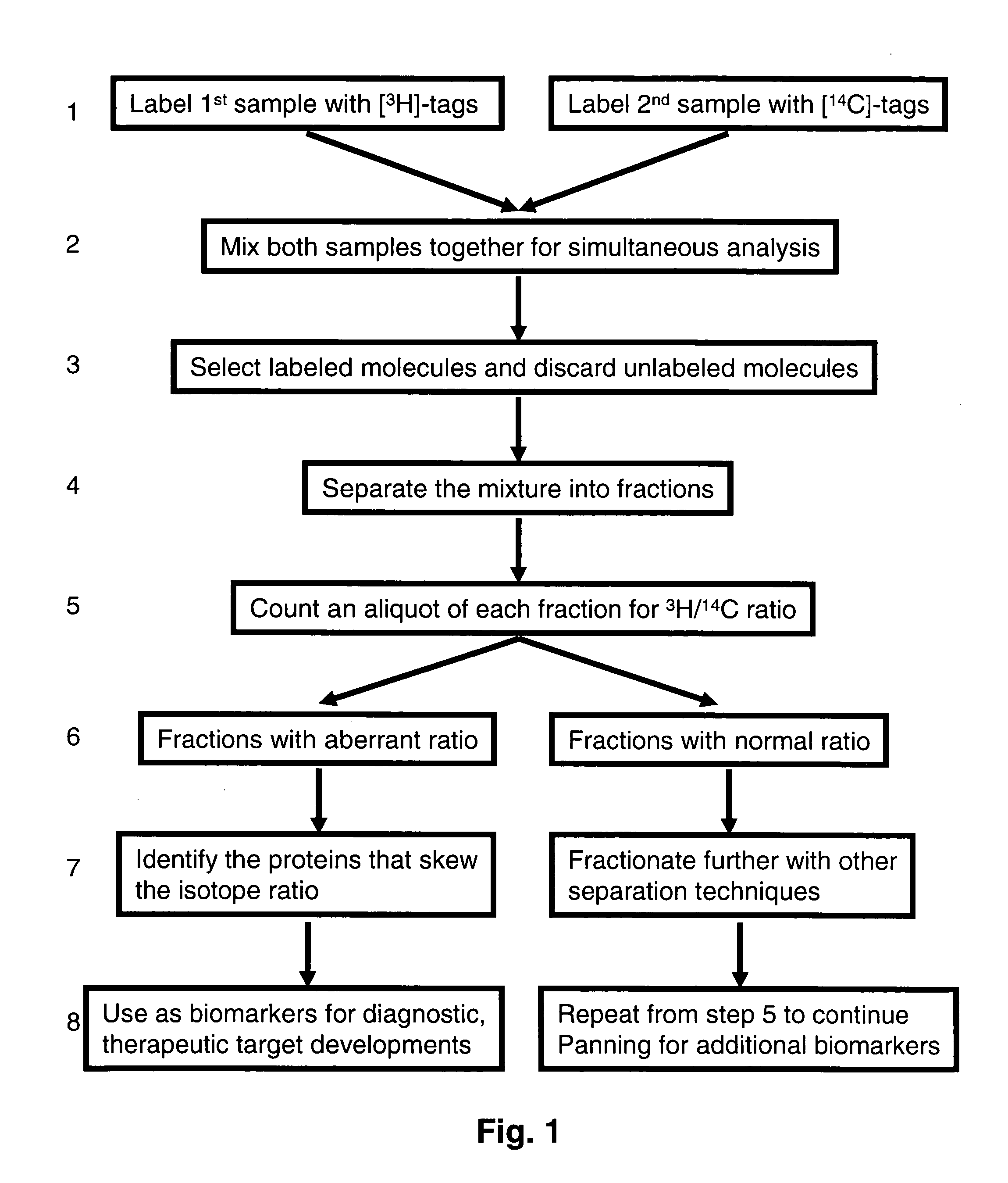Methods and reagents for differential proteomic analysis
a technology of differential proteomic analysis and reagents, applied in the field of methods and reagents for differential proteomic analysis, can solve the problems that the analysis of mass spectra itself is still a very expensive and time-consuming process, and achieve the effect of improving the analysis
- Summary
- Abstract
- Description
- Claims
- Application Information
AI Technical Summary
Benefits of technology
Problems solved by technology
Method used
Image
Examples
example 1
Biomarker Discovery Process Using Two Biological Samples:
[0059]Equal amount of blood plasma sample from a person when he is healthy and when he is sick are used to pan for protein changes in the plasma proteome as a result of the ailment. The objective is to discover proteomic changes associated with the ailment. One plasma sample is labeled with a cleavable biotin labeling reagent (reactive group-SS-biotin) containing tritium, while the other sample is labeled with a chemically identical reagent containing carbon-14. Both samples are then combined and allowed to bind to strepavidin-sepharose (packed as an affinity selection column). The column is then washed with various buffers to remove unlabeled molecules and other non-specific interactions. Then buffer containing reducing reagent dithiothreitol is used to reduce (cleave) the SS bond. This cleavage releases the labeled molecules from the column for use in analysis. One population of this molecule will contain 3H-tag while the ot...
example 2
Comparative Analysis of Three Samples
[0067]Biological samples from a patient treated with a know drug, a placebo and an experimental drugs are used for protein profiling comparison in this experiment. All samples are labeled with radioactive imino-biotin labeling reagent. One sample is labeled with 3H, another with 14C, and another with 35S. All three samples are mixed together and affinity select by strepavidin column. After unbound molecules are washed away, bound molecules are eluted with buffer having pH less than 4. These molecules are neutralized, non-specific proteins may be added, and then bind to a protein array. Washing and further non-specific competition removes non-specific bindings. Radiation signals from the array are quantified to determine 3H signals, then quantification before and after a decay period determine 35S signal and calculation yield 14C as remaining signals. The protein pattern of changes due to known drug treatment and experimental drug treatment can be...
example 3
Alternative Approach to Identifying Differentially Abundant Proteins Between Samples.
[0068]A person's biological sample is taken when he is healthy and labeled with selective labeling reagent containing a long-live radioactive isotope such as 14C. Labeled molecules are stored in aliquots for used in later assays. These labeled molecules are tested for competitive binding with the same unlabeled sample by binding to a protein array to ensure that labeled and unlabeled molecules can compete and bind fairly equally. For instance, using enough proteins to saturate all spots on the protein array, a 50 / 50 mixture of labeled sample and unlabeled sample should yield 50% signals for all spots compared to just 100% labeled sample alone.
[0069]When the person is sick, the same type of biological sample can be taken and mixed with labeled sample taken when healthy and profiled on a protein array. Theoretically, equal amount of unlabeled proteins and labeled protein will reduce the signal read eq...
PUM
| Property | Measurement | Unit |
|---|---|---|
| atomic mass | aaaaa | aaaaa |
| radiation energy | aaaaa | aaaaa |
| temperature | aaaaa | aaaaa |
Abstract
Description
Claims
Application Information
 Login to View More
Login to View More - R&D
- Intellectual Property
- Life Sciences
- Materials
- Tech Scout
- Unparalleled Data Quality
- Higher Quality Content
- 60% Fewer Hallucinations
Browse by: Latest US Patents, China's latest patents, Technical Efficacy Thesaurus, Application Domain, Technology Topic, Popular Technical Reports.
© 2025 PatSnap. All rights reserved.Legal|Privacy policy|Modern Slavery Act Transparency Statement|Sitemap|About US| Contact US: help@patsnap.com


